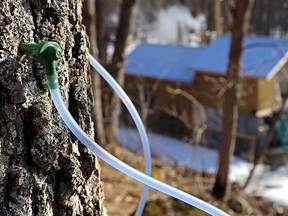Food for Thought: Maple syrup a truly Canadian product
The maple syrup season is here and gone, which is a sure sign of spring being just ahead, though this winter has not really been that bad.

Article content
The maple syrup season is here and gone, which is a sure sign of spring being just ahead, though this winter has not really been that bad.
Maple syrup is a truly Canadian product, as we produce 70 per cent of the total world’s supply. Quebec produces nearly 90 per cent of this, Ontario 10 per cent, and Nova Scotia and New Brunswick produce most of the rest. In Canada, the value of maple products (sugar, butter and syrup) is about $500 million. There are more than 11,000 maple farms in Canada and 47 million taps.
In the fall, sugar maple trees lay down concentrated sugars in their rays (groups of cells that carry and store nutrients). These sugars mature during winter and are harvested while the frost is still in the ground. Sap flow is stimulated in spring as days become warmer and temperatures rise above 0 C in daylight, followed by below-freezing nights.
This year, with the warmer temperatures, sap flow was much lower than usual, so some producers only saw one-third of their usual maple syrup production.
Within the tree, positive pressures created by temperatures above 0 C produce a natural flow of sap. When a tree’s internal pressure is greater than the pressure outside, its sap will flow out of a tap drilled into the tree – or out of a broken limb or split in the bark. The clear sap rushes out of these taps into the collection system.
As pressure in the tree drops during the day, sap flow slows and stops. Negative pressure is now within the tree, which begins to absorb water through its roots. Next day, as the tree warms up, positive pressure is restored, creating another sap flow.
This process continues for about six weeks in early spring, between March and April. After that, sap takes on a cloudy appearance, and sugar content drops dramatically.
During the height of the sugaring season, sap contains two to five per cent sugar. Near the end of the season, that drops to less than one per cent. During the maple harvest, a tree will release about seven per cent of its sap. Tests confirm this does no long-term damage to the tree. Many tapped trees are well over 100 years old.
In Chatham-Kent and Essex County, several producers make their own maple syrup and sugar products. You can find these on the Buy Local Buy Fresh maps. Let’s support our local producers whenever we can.
Think about this – No matter where we are, Jesus is only a prayer away.
Just some food for thought.
Kim Cooper was involved in the agribusiness sector for over 45 years. He can be reached at kim.e.cooper@gmail.com


Postmedia is committed to maintaining a lively but civil forum for discussion. Please keep comments relevant and respectful. Comments may take up to an hour to appear on the site. You will receive an email if there is a reply to your comment, an update to a thread you follow or if a user you follow comments. Visit our Community Guidelines for more information.